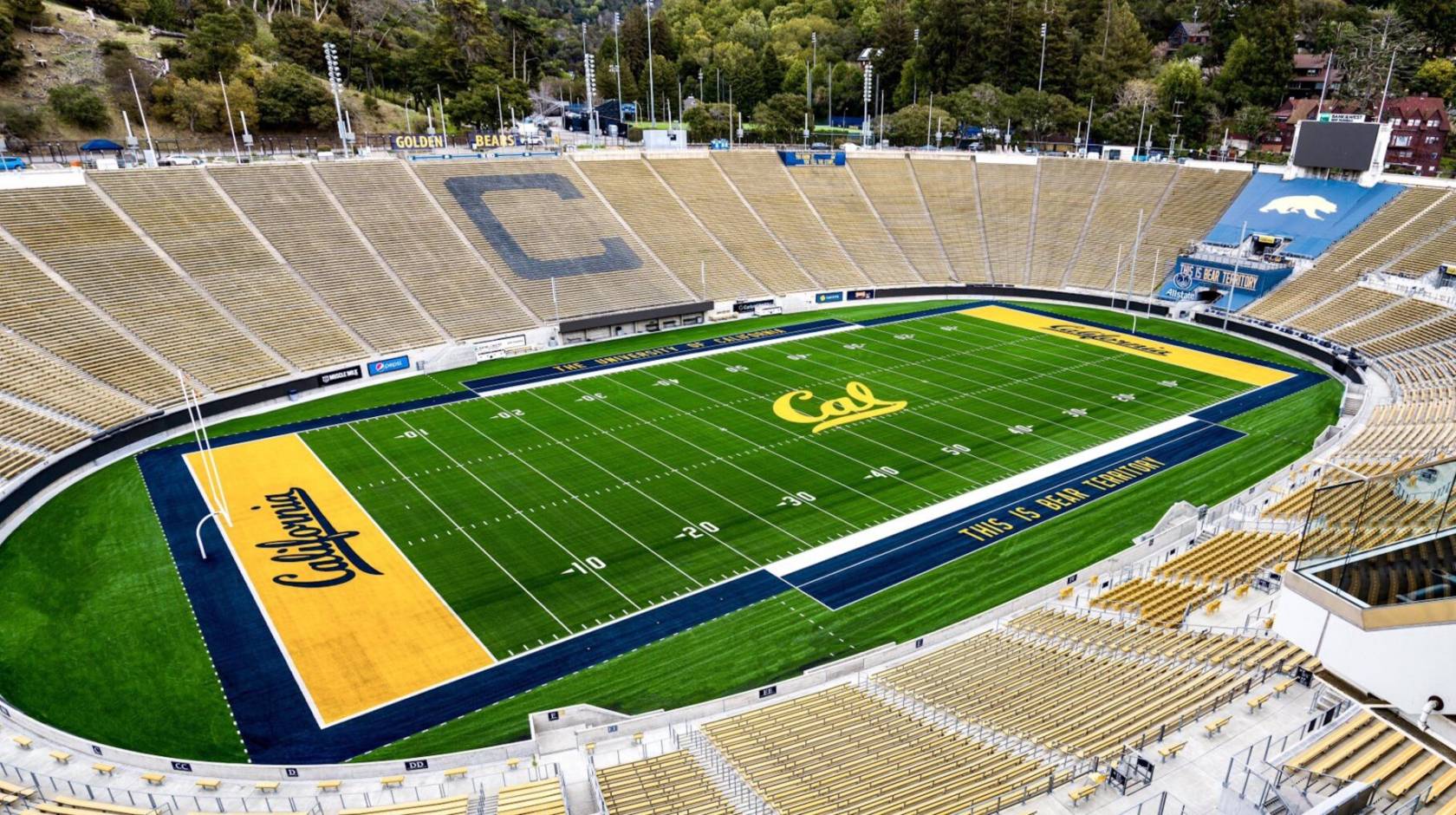Margie Cullen, California Magazine

The Pac-12 fell apart slowly, then all at once.
In 2022, UCLA and USC announced they would be leaving for the Big Ten in 2024. Then in August, six more members of what was originally called the Pacific Coast Conference declared their planned departure, leaving the self-branded “Conference of Champions” in shambles with just four teams remaining: Cal, Stanford, Washington State, and Oregon State.
On September 1st, Cal announced it too would be leaving the Pac-12 and joining the Atlantic Coast Conference (ACC) along with rival Stanford. The move shocked many fans and observers, not least of all for the obvious absurdity of the name; after all, Cal students can see the Pacific Ocean from campus.
“It doesn’t make geographical sense, I know,” admitted UC Berkeley Chancellor Carol Christ, who recently sat down with California magazine to discuss how and why this happened, and what it means for Cal Athletics moving forward.
The interview has been edited for length and clarity.
A lot of people were surprised by the Pac-12 implosion. Were you also surprised?
I was surprised how fast it happened, but it was a result that both I and [Athletic Director] Jim Knowlton predicted when UCLA and USC left. I mean, it happened within a week. That was surprising, but that it happened at all, I was not surprised.
How could an institution like the Pac-12, which has roots going back more than a century, fall apart seemingly overnight?
I think the easiest way to answer that question is really by a narrative.
The precipitating event was USC and UCLA’s leaving. That really diminished the media value of the conference. Most of the estimates I’ve seen say [their departure] diminished the value of the conference by 30 percent. And then there was a kind of increased eagerness and anxiety to figure out what the Pac-12 media deal was going to be. If it was good enough, the Regents might tell UCLA to return to the Pac-12 and figure out some way of paying the penalty of withdrawal. So there were a lot of pressures on the Pac-12 to go to market. But at that very time when they were going to market, there were economic challenges in the media and streaming market that made it difficult to come to a media agreement.
This went on for months, maybe eight months or so. Finally on July 25th, George Kliavkoff, the commissioner of the conference, said, “I’m going to have two deals to present to you on August 1st, and after you find out what the features of these two deals are, I ask that nobody make any decisions until we meet together as a conference.” Even though there was increasing restlessness and restiveness in the conference, everyone solemnly goes around the table and swears. And July 26th, Colorado left.
Then on August 1st, the commissioner presented not two, but one deal (one of the deals fell apart as a consequence of Colorado leaving). The deal that was presented was from Apple. It’s a streaming medium, so there wasn’t guaranteed access to broadcast TV, and it wasn’t as much money as some conference members were hoping. So we set another meeting date, August 3rd, two days later to decide. Again—solemn meeting. We all said, “yes, yes, we’re going to sign this deal.” We had a meeting at seven the next morning on August 4th, and at 6:45 a.m., Washington and Oregon left. Then, that very day, the remaining schools met with the ACC, and everybody said, “Yeah, yeah, yeah, we’re really interested in the ACC.” The next day Arizona, Arizona State, and Utah left for the Big 12. And then there were four.
The joke I make, I’m not sure it’s in terribly good taste, but I say, “in a week Kumbaya turned into Lord of the Flies.” The collapse was amazingly fast. And I was shocked, frankly, by the fact that people I trusted were clearly having other conversations.
So it sounds like there was at least some attempt to keep the Pac-12 together first.
There certainly was. But still at this point, I wonder to the extent that other schools were committed to the Pac-12 staying together. But, yes, certainly that was true of Berkeley; it was true of Stanford. We really wanted the Pac-12 to survive.
So then it’s the Pac-4. At that point, was there the thought to rebuild the Pac-12?
We certainly asked that question among ourselves, but we thought that the path to rebuilding the Pac-12 was a hard and long one because any school that’s currently in a conference would have [to pay] an exit fee. And sometimes those exit fees are lots and lots of money. So it’s not a foregone conclusion that if you knock on a school’s door, even a school that’s not in as highly ranked a conference, that they would necessarily say yes, just because of the penalties for withdrawing.
What was really important to us was to have the opportunity for our athletes to compete at the highest level. And that’s something the athletes kept telling Jim Knowlton—we want to compete at the highest level. That means being a Power five conference, essentially.
What does this mean for the student athletes going forward? Obviously a lot more travel.
It doesn’t mean as much more travel as you think. So, 19 of the teams are not affected. Sports like beach volleyball and water polo aren’t played on the East Coast, so they stay in their current leagues. Some play in meet formats or in tournament formats in which a lot of teams go to a central place. Some already play in an Eastern conference—like field hockey already is in an Eastern conference.
I’m not as worried about football as some of the other sports in that they only play 11, 12 games, half of the games are at home, and they already travel just to create visibility in other parts of the country. So this will mean they’ll travel for conference games rather than non-conference games. The teams that I’m really worried about are teams that play multiple games a week and typically in the gym or on the fields of the competing teams. So: men’s basketball, women’s basketball, men’s soccer, women’s soccer, baseball, softball, volleyball.
What is it going to look like for those teams, juggling the academics and increased travel?
I think, at the most, the teams make an additional trip to the East Coast because, again, so many of the teams already have exhibition games there.
We’re trying to minimize the travel. It indeed is true that a trip to the East Coast is longer than a trip to many of our Pac-12 partners. But even getting to Pullman, Washington is not easy. And Seattle: We played in Seattle, not this past Saturday, but the Saturday before that. I was told that they got back at like four in the morning. The travel differences, I certainly regret them, but they’re not as extreme as you would think.
This happened a relatively short time ago, so we’re just beginning to work on the scheduling. But we will try to supply more academic support on the road for our athletes.
Washington is a big flight, but it’s at least in the same time zone.
Is it an ideal situation? No. I think it would have been an ideal situation if the Pac-12 had been able to negotiate a competitive conference and hadn’t collapsed. That unfortunately isn’t the situation we find ourselves in.
Obviously I have to ask about the financials because it feels like Cal’s taking a hit.
It is taking a hit because it’s going to return a contribution to the conference and have—we’re not calling it a partial membership—but it essentially reduces the amount of revenue that we’ll get from the TV deal. And it’s in the first nine years of the deal. Then after that, we’re full members. We just have to think hard about what a budget plan is going to be that will help us meet the financial challenge that athletics is going to face for the next nine years.
What does this mean for non revenue-generating sports?
I don’t want to cut sports. What we’re hoping to do is make up this difference with revenues. There is a question of whether the Regents will require UCLA to pay us some of the money that it’s making from the Big Ten. That will be one piece of a deal. We’re working very hard right now on putting together a financial plan.
What’s going on with recruitment?
What I’m hearing from athletics is that when conference membership was up in the air, they couldn’t get athletes to visit, and now they’re getting really good and really competitive visits from the top candidates. So it seems to be good for our athletic recruitment.
What does this mean for fans who want to watch games, but find themselves needing to travel a lot further to do so?
I feel bad for them. I feel particularly bad for the parents of athletes. And yes, it’s true, if your aspiration is to go to all of our conference games, you’re going to be logging a lot more miles on your frequent flier card.
And of course, there’s all the traditions of the Pac-12. At least we still have the Stanford rivalry… What do you think about this loss?
I feel terrible about it. The Pac-12 is just a storied conference and has so many national championships. The Director’s Cup, which is the cup that goes to the school that has the best all-around athletic program, was won by Stanford last year. It just feels terrible to me that this wonderful conference with so many great traditions is collapsing. I know that Washington State and Oregon State may try to reconstitute.
I would much rather that we were looking forward, at the end of the season, to many more seasons of the Pac-12.
Do you think the ACC is going to be our home indefinitely, or is this just a stopping point?
I just don’t know. Nobody has a crystal ball. This is as turbulent a landscape as I’ve ever seen in college athletics. Some people are speculating that football may become one or two national conferences. So I don’t think we’ve seen the end of this yet. But I’m really excited about the ACC. They’re terrific schools. I’m sure we’ll draw closer to them as universities, and it’s exciting for our basketball players to think of playing these legendary basketball greats like Duke and North Carolina.
Is football too powerful?
I have come to be very critical of the way in which football is driving—well, I shouldn’t say football—it’s the television appeal of football that is driving so many decisions in intercollegiate athletics. And I believe that our female gymnasts, our male baseball players, our male soccer players are just as valuable as our football athletes. But that’s not what the media contracts look like.
What do you think of this idea of super conferences, of everyone coalescing?
The numbers don’t mean anything. The Pac-12 is the Pac-2, the Big Ten is the… Big 18? It’s very strange.
It depends on what the sport is. I think it might make sense in relation to football, but I don’t think it makes sense for sports that really should have a more local network of competitors. Sports like soccer. Sports like volleyball. Sports that really are built on multiple games that you play at your opponents’ campuses.
So, in the end, can we just blame UCLA?
Yeah. You know what they’re calling the UCLA payment?
Cal-imony.

